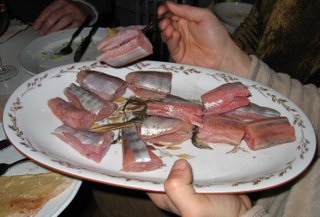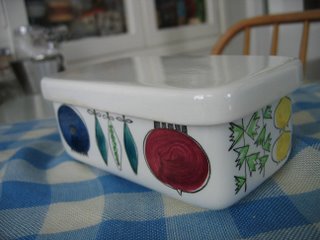Monday, June 26, 2006
 Sour fish 2
Sour fish 2In Norway's countryside there is small-scale production of rakefisk, a dish prepared from trout - rakørret - or arctic charr - rakrøye. Unlike herring, the fish is cleaned out and cut into pieces, before it is fermented for a couple of months at low temperature with salt and a little sugar added. If the process is going in the right way there should be a breadish smell about it.
The charr has a milder taste but the trout improves after being stored a half year. Served with boiled potatoes and Norwegian flatbread this smooth fish is a great experience. The specially spiced brand of aquavit that should accompany this is rare in liquor stores.
Wednesday, June 21, 2006
 Sour fish 1
Sour fish 1 Our neighbours invited us for sour herring some days ago (not this brand though). This is a delicacy every time whether served with only fine boiled potatoes and a lager beer, or with (hopefully freshly homebaked) thin white bread and onions, or even tomatoes. Last years release is usually the best choice, if not the next to last - the flesh should not be to firm, and there should be a gaseous feel to it.
It is a pity that only few brands remain out many that existed a few decades ago. Maybe we can hope for a development like the beer market? The eating habit seems to spread down into the south. I still remember the best herring I ever had, thirty years ago - the taste, like an old danish cheese, and the green colour of the can.... unfortunately not the name of the brand though - but that would not help revive it anyway.
I was happy to hear my cousin, who fishes his own herring, tell me that he is learning to make his own sour herring. I hope to have the chance to try that later on....

This is not a design blog
However I can't resist commenting on how everyday wares are turned into collectors items. The likes of this butter container from Rörstrand, Picknick no 44, designed by Marianne Westman in the 1960's, are now sold on auctions even in England. On one hand this is an acknowledgement to fine Swedish design and a sign that it should be valued. On the other hand how can you dare to use it when you know that its value in £ or SEK will go on increasing? To read more about Picknick and its relatives in the Pomona series, click here.
If you want to read about Marianne Westman, click here!
If you want a real design blog instead, click here!
Tuesday, June 20, 2006

The little-known Messapians lived in what is today the Salento region. They were at odds with the Greeks in the area and the two peoples fought each other until they were both conquered by the Romans. Their equally little-known language is said to be of Illyrian origin so they might have come from the East. Lithuanian linguists (note alliteration) consider it to be similar to Baltic tongues which is controversial but maybe gives to these a more civilized aura.
At Roca Vecchia we found a large field of ruins where excavations apparently proceeded very slowly if at all. We had to cross a cut-up barbed-wire fence to find this attraction which was listed in our guide-book. If the ruins had been of Italic origin they probably would have been well studied and marked-up, maybe even with some information signs! Messapians are left to oblivion instead of being recognized among the roots of Italian culture.
It seems though that some recent traces have been found in New York City...
Click to read the play about the last Messapians!
Friday, June 16, 2006
 Ricci in Puglia
Ricci in PugliaRicci are seasonal seafood, only used when they breed. The ovaries, "corals" in English, are eaten raw (alive, actually) with a small spoon or a piece of bread after they are opened with a ricci opener. We found them in April on the coast between Otranto and Lecce. The are both salt and sweet. We were served by Marcello in his small provisional shelter on the coast (the picture is NOT on Marcello). The price was 10 € for about 15, including bread. A friendly customer who was finished gave us his half full wine bottle - this is BYO country.
My mediterranean seafood bible tells about a number of ways to prepare ricci: Oursinado (soup), Omelette d'Oursins and Daurade (Guilt-head bream) à la Crème d'Oursins. Or simply in the scrambled eggs. Save one coral for decoration!
 A day in the archipelago
A day in the archipelagoThe air is filled with terpentic, oily and tarry smells as boats are being prepared for the summer's use. Missing details need to be fixed and replaced. Soon it is time for the annual post rowing adventure between Sweden and Finland in traditional boats. This is a way to honour past generations of archipelago people and understanding something of their ways. For them life was very much about rowing and sailing whether they were fishing, looking after cattle, collecting hay, or hunting seals. A difference is that we have mobile phones, gps, and modern life vests. They were totally dependent on themselves.
Wednesday, June 14, 2006

Not A Good Idea
Jan Leopoldovich Larri was a latvian author who wrote an anonymous letter to Stalin in december 1940, with part of a science fiction manuscript "Visitors from the sky" describing the future of the Soviet Union a century later, from a visiting Marsian's point of view. It was not altogether a pretty picture he painted. So Stalin's agents of course found out who sent the letter and Larri was to spend the next 15 years in the GULAG.
He is famous for the children's book "The wonderful adventures of Karik and Valja". Read more about this in part 25 in the series "Insekternas litteraturhistoria" in the latest issue of "Natur i Norr", see http://www.emg.umu.se/biginst/andersn/09_ins_litt_25.pdf
Back issues from 2002 and on are found at: http://www.emg.umu.se/biginst/andersn/NEF_NiN.htm - with Strugatski brothers, subcomandante Marcos, Tranströmer and many others.
Monday, June 12, 2006

A night in the archipelago
At last - time for archipelago nature. Travelling in boat at night among the islets. The boat passes slowly over the shallow areas. Black guillemots swarm like big insects, velvet scoters like heavy black projectiles, arctic terns and black-backed gulls hover over the boat. All islets are different individuals. The sun goes down over Grossgrundet. The night is surprisingly warm and never gets dark. Still, we can see flickering of the lighthouses - white light of Holmögadd, and green of Stora Fjäderägg. For how long will they still send their beams over the straits of Kvarken, in this era of satellite-directed navigation?
Tuesday, June 06, 2006

On Time
A few days ago I had an uplifting experience of finding a total creative flow together with a group of people I had not seen for three decades (yes I am that old). Could it be that we remembered how to cooperate in a dynamic way, over all the time that had passsed? And knew exactly to what degree we should respect or confront each other?
I had reasons to reflect on what it is we recognize in people over a longer period of time. A beard or a moustache, hair style – these are important at first. After a while, the person you used to know works his/her way out through the surface and becomes visible again.
I also reflected over the self. What does it mean to develop over time? Who was I then? Who am I now? What has changed and why? In what sense am I the same person as 32 years ago, and in what not?
We discussed the ideas we had in common and ideas that differed. I found out that differences in political ideas, seemingly big at that time, were in reality only superficial. We had much more values in common than we realized at that time. How much are these tied to our being of a certain generation? The common identity maybe was in the discourse itself?